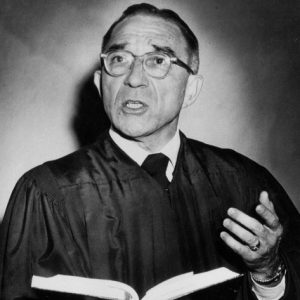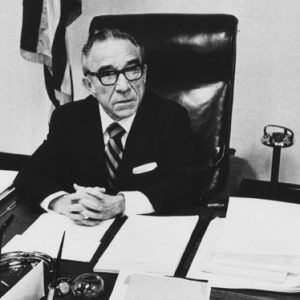calsfoundation@cals.org
Ronald Norwood Davies (1904–1996)
Ronald Norwood Davies was the U.S. district judge who presided over the litigation involving the 1957 integration of Central High School in Little Rock (Pulaski County).
Ronald N. Davies was born on December 11, 1904, in Crookston, Minnesota, to country editor Norwood S. Davies and his wife Minnie M. Davies. In 1917, the family of seven moved to Grand Forks, North Dakota, where Davies completed elementary school. In 1922, he graduated from Central High School in Grand Forks and went on to attend the University of North Dakota. Davies received his BA degree from the University of North Dakota, College of Liberal Arts, in 1927 and, three years later, earned a law degree from Georgetown University in Washington DC.
Davies then began his law practice in Grand Forks, where, in 1932, he was elected to the part-time position of municipal judge, a position he held for eight years. Davies was also appointed to the North Dakota State Board of Pardons in 1933, and in 1940, Davies began a legal partnership with attorney Charles F. Peterson of Grand Forks.
Davies married Mildred M. Doran on October 10, 1933. The couple had five children.
Davies was called into military service in World War II on January 15, 1942, entering service as a first lieutenant. Required to obtain a waiver to enter the armed forces because of his 5’1″ height, Davies served during the war as commander of the reception station and induction center at Fort Snelling in St. Paul, Minnesota, for the duration of World War II. Davies was discharged from active duty on October 7, 1946, having attained the rank of lieutenant colonel.
After the war, Davies returned to the practice of law while acting as part-time executive director of the North Dakota Bar Association, serving two terms on the state Board of Pardons, teaching at the University of North Dakota Law School, and participating in a number of other civic and philanthropic activities. Davies was appointed U.S. district judge for the District of North Dakota in 1955 by President Eisenhower at the behest of Senator William Langer of North Dakota.
Preceding Davies’s involvement in the case, the Arkansas state legislature had adopted an interposition resolution and a state constitutional amendment blocking desegregation and had also passed four laws aimed at preventing progress on desegregation. Based on these legislative enactments, a state chancery court issued an injunction to stop desegregation. On August 29, 1957, Judge John E. Miller, federal judge for the Eastern District of Arkansas, who had previously sustained the Little Rock School Board’s phased integration plan, asked to be relieved of further involvement with the litigation because of the backlog of cases caused by the retirement of one of Arkansas’s district judges. Chief Judge Archibald Gardner temporarily assigned Davies, then a federal district judge for North Dakota, to assist with the Arkansas district court’s business, including the desegregation case, as a presiding district judge.
Davies first ruled that the state chancery court had no jurisdiction over the school case and enjoined its injunction, ordering that desegregation proceed. After Governor Orval Faubus ordered the Arkansas National Guard to surround the high school, preventing the nine African American students from entering the school on September 4, 1957, the Little Rock School Board asked for a delay. Davies responded by repeating his order that integration be implemented “forthwith.” Davies then asked the Department of Justice to investigate the disruption in the implementation of the desegregation order. After reading the subsequent report compiled by the FBI, he directed the department to file a petition for injunction against Faubus.
After a Newport, Rhode Island, meeting between Faubus and President Eisenhower failed to end the crisis, Faubus’s attorneys walked out of a court hearing on September 20, 1957, asserting state sovereignty. Judge Davies issued a preliminary injunction against the governor, who then removed the National Guard from Central High School.
After withdrawal of the National Guard on Friday, September 20, a mob consisting of approximately 1,000 white citizens forced the withdrawal of the Little Rock Nine from the school the following Monday. Eisenhower ordered the 101st Airborne division of the U.S. Army from Fort Campbell, Kentucky, to Little Rock on September 24 and nationalized the Arkansas Guard. The Little Rock Nine were finally allowed to attend classes on September 25, 1957, escorted by the 101st Airborne.
Davies was named Outstanding Georgetown Law School Alumnus for 1958, among other honors he received following the rulings in the Little Rock case.
Davies took senior status (a condition of semi-retirement in the judiciary) as a district judge in 1971 but continued to preside over district courts throughout the country. He died in Fargo, North Dakota, on April 18, 1996, and is buried at Holy Cross Cemetery in Fargo along with his wife. In 2002, the Grand Forks Federal Building was renamed and dedicated in Davies’s honor.
For additional information:
“Ronald Norwood Davies.” In Judges of the United States. 2d ed. Washington DC: Bicentennial Committee of the Judicial Conference of the United States, 1983.
Tharaldson, Ardell. Patronage: Histories and Biographies of North Dakota’s Federal Judges. Bismarck, ND: North Dakota Branch of the Historical Society of the United States Courts in the Eight Circuit, Northern Lights, ND Press, 2002.
Wilson, William R., Jr. “Little Big Man—United States District Judge Ronald N. Davies.” University of Arkansas at Little Rock Law Review 30 (Winter 2008): 303–310.
Jeffrey B. Morris
Touro Law Center
 Ronald Davies
Ronald Davies  Ronald Davies
Ronald Davies 



He was a giant among judges and he was my father.